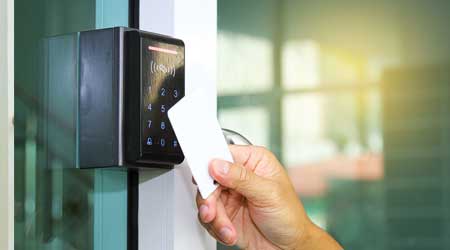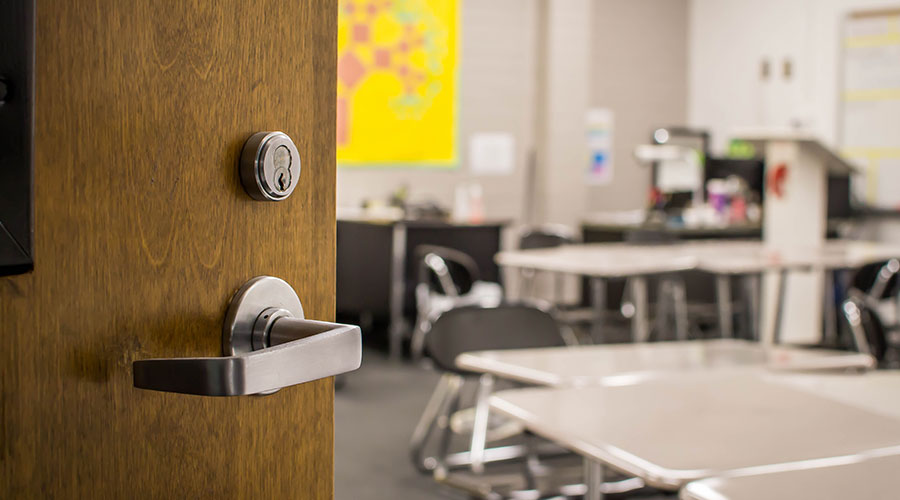Touchless Doors Strategies to Slow the Spread of Coronavirus
Touchless technologies like wave-to-open switches and personalized keycards or credentials at entryways are important strategies for keeping occupants safe.
OTHER PARTS OF THIS ARTICLEPt. 1: This Page
What began as a seemingly localized endemic in Wuhan, China, rapidly evolved into the global COVID-19 pandemic. In a matter of months, the coronavirus enveloped the world and upended nearly every aspect of institutional and commercial facilities.
To limit potential vectors of virus transmission in these spaces and to protect occupants and visitors, maintenance and engineering managers continue to upgrade exterior and interior areas that affect the way occupants and visitors move into and through facilities and work in office environments. Upgrades of entryways in particular need to balance the need for safety and health with ease of use and long-term performance.
Laying the groundwork
When retrofitting to limit the threat of COVID-19 in a facility, maintenance and engineering managers need to take into account the potential occupant capacity and the most probable modes and areas of virus transmission. Before taking on larger renovations, it is important to provide occupants with temporary or semipermanent safety measures that offer instant relief and create a comfortable environment.
Immediate preventive procedures should include installing personal sanitation stations, supplying adequate cleaning supplies, mounting protective barriers, and displaying visual educational aids that emphasize safety protocols. These protective measures should be implemented equally throughout the facility and monitored and restocked frequently.
It is important to reduce areas that promote social interaction and potentially increase the rate of COVID-19 transmission. By using floor plans and altering space planning, managers can remove unnecessary equipment, furniture and decor in order to create space and further enforce social distancing. They also can arrange for furniture to be strategically placed in pathways or doorways to limit roaming and reduce unnecessary interaction. Inherently communal areas, such as cafeterias and waiting rooms, should be closed or have strict limitations in place to inhibit contact. Once managers make adequate preliminary adjustments, they can move on to larger modifications.
Doors to safety and health
COVID-19 has inspired the adaptation and invention of a variety of products managers can use to redefine the entryways and security systems of facilities. They have increasingly incorporated touchless or automatic entryway technology into facility retrofits in recent years as a way of increasing convenience for occupants and visitors. In the COVID-19 era, the technology also offers an effective and accessible way to ensure safer public environments by reducing potential threats to human health. Managers will have to determine the specific types of touchless technology best suited for their particular facilities.
The most basic way to upgrade a facility’s doorways is to install motion sensors. This device can sense movement up to 10 feet away and will keep a door open when large crowds of customers enter. The sensor is not a reliable form of security because random movements can trigger it and it does not have access control.
Another relatively simple way to upgrade existing doorways is to install a wave-to-open switch. This accessory can detect motion within 4-5 inches and significantly reduces the unintended opening of the door. As with a motion sensor, it does not offer access control and should not be the only source of security for a facility.
One complex way to convert a facility’s entryways is to install technology that individualizes access to a facility by using mobile or personalized credentials — key fobs, key cards, Bluetooth or smartphone apps, and voice or facial recognition. These types of hands-free technology offer the most security and allow managers and staff to closely monitor and control access to the facility.
This technology is appealing because it requires the use of personal devices and significantly limits interactions with potentially infected surfaces. But as the technology becomes more advanced, the possibility of encountering complications increases. For instance, installing sophisticated hands-free access technology might be undesirable or too complex for the customers, employees or occupants of certain facilities. Additionally, the probability of post-installation maintenance necessary for products such as these can increase and require greater attention.
Managers also can opt to replace or transform the doorways of a facility. Depending on the length of time required for installation and the type of facility, managers can specify automatic revolving doors, security turnstiles, or mantrap portals for installation at key entrances. Automatic revolving doors and security turnstiles are similar. Turnstiles permit only unidirectional use, while revolving doors can be used by individuals entering an existing building simultaneously.
A mantrap portal is a small airlocked space between two independently locked doorways. Mantraps guarantee social distancing and offer the most advanced security, but they sometimes require individuals to physically unlock both doors. Such entryways are best suited for facilities that require sophisticated security.
Scott Lance, LEED AP O+M, is a project engineer with Horizon Engineering Associates, which specializes in building commissioning and energy analysis.
Related Topics:












